THE GREAT DIAMOND SWINDLE
In May of 1872, a pair of poorly educated cousins named John Slack and Phillip Arnold managed to dupe some of the country’s richest, most powerful and influential men. When the pair first nervously walked into the Bank of California and said they had diamonds they wanted stored in the vault, the bank’s founder William Ralston was reportedly a bit suspicious. Unfortunately for Ralston (and numerous others), he was suspicious for the wrong reasons.
The diamonds were real, to Ralston’s mild surprise, but the cousins were hesitant to say where they had acquired them. Eventually, the pair reluctantly admitted that they had found a field of diamonds and other rare stones, and ,after much prodding, agreed to show their findings to a number of prominent potential investors. They took the business representatives on a circuitous journey (sometimes blindfolded) designed to confuse the companions and prevent them from knowing the precise location of the mine. It was later revealed that the location was in northwest Colorado, some ways east of Dinosaur National Monument. The location is still known as Diamond Peak.
Eventually, the cousins led the potential investors to a field where they found many precious stones, including not only diamonds, but rubies as well. A sampling of the stones was sent to Tiffany’s, which quickly estimated their worth at roughly $150,000. This unsurprisingly caught the attention of even more investors. Word spread among certain affluent circles, and soon the cousins added a number of additional investors, including the likes of Baron von Rothschild, Asbury Harpending, Horace Greeley and Charles Tiffany himself.
The Department of the Interior sent several geologists to survey the mine, led by Clarence King. The report produced opened with the sentence:
“Gentlemen: I have hastened to San Francisco to lay before you the startling fact that the new diamond fields, upon which are based such large investment and such brilliant hope, are utterly valueless, and yourselves and your engineer, Mr. Henry Janin, the victims of an unparalleled fraud.”
It was eventually revealed that Slack and Arnold had salted the region with mostly cast-off detritus from gem-cutting establishments in London and Amsterdam. “Salting” is the term used for scattering samples of a desired stone or mineral around a region to give prospective buyers the impression that the land has value. For example, gold dust was sometimes loaded into a shotgun, then fired so that the mineral would be embedded within the walls of a mine, giving the impression it was naturally occurring.
The geologist’s report, while being as diplomatic as possible so as not to offend the powerful and influential investors, made it very clear that this hoax should have been recognized much sooner than it was. For one thing, diamonds and rubies form under very different conditions, and it is exceedingly rare for them to be found in the same location. Further, the sampling of gems which had so generously been appraised at $150,000 were in fact worth no more than $20,000 at the outside. (Tiffany reluctantly admitted he had had no previous experience with uncut diamonds, and grossly overestimated their value.) Finally, the fact that some of the stones had clearly been cut should have been a dead giveaway to anyone with even a limited knowledge of gemology.
By the time the report was released, Arnold and Slack had quietly disappeared. Philip Arnold returned to his home in Kentucky, where he opened his own bank. He was eventually tracked down and forced to return an undisclosed amount of money in exchange for avoiding litigation. In 1879, he was shot during an argument with another banker and, soon after, died of complications from his injury.
John Slack reportedly moved to New Mexico, where he opened a business as a casket maker. He never faced any repercussions from his participation in the swindle and died of natural causes in 1896.
William Ralston, in order to save face and restore his reputation, took it upon himself to repay many of the investors out of his own pocket.
A MUCH LESSER DIAMOND SWINDLE
In 1967, a far less ambitious (but likely equally profitable) diamond swindle was brought to an abrupt end when the Colorado Investigations Bureau arrested Nicholas Digiallonardo and Antonio Ciccarelli. The pair were well known to law enforcement in Denver both as gamblers and as “mobsters” with ties to organized crime.
The team’s con amounted to a fairly basic bait-and-switch routine. As is fairly common in scams of this nature, the target of the ploy had to possess a willingness to be a bit shady themselves. Digallonardo and Ciccarelli would inform their potential mark that they had some diamonds they were looking to sell at a deep discount…no questions asked. Generally, this amounted to $100,000 worth of stones for only $7,500. The diamonds were shown to the target and could even be appraised by professionals. However, once the transaction was to be finalized, the gems were swapped for largely worthless imitation stones.
The scheme relied heavily on the fact that their victims couldn’t go to the police without admitting that they had been trying to purchase a stash of jewels under suspicious circumstances. However, they hadn’t counted on Kaylor Glasgow, a Denver area salesman. On September 8, 1966, Glasgow filed a complaint with the police. He was later able to identify Digiallonardo and Ciccarelli, though a third accomplice remained unknown.
The pair were charged with (and ultimately convicted of) running a confidence game, and conspiracy to commit a confidence game. One thing to note is that while this, on its own, was a relatively small-time con, it’s believed that Diagialonardo and Ciccarelli were part of a much larger ring which ran similar ruses throughout the country, and even into Canada.
These stories, and a great many more, can be found within the Western History and Genealogy clippings files. Be sure to like our Facebook page to stay apprised of upcoming events.



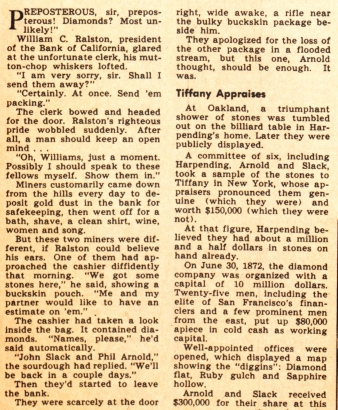
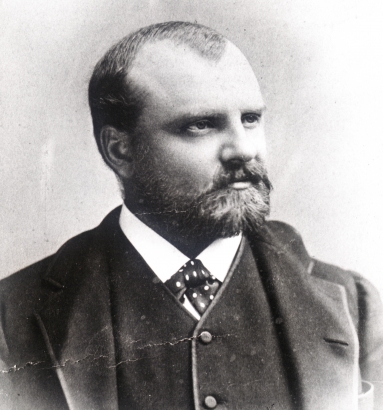
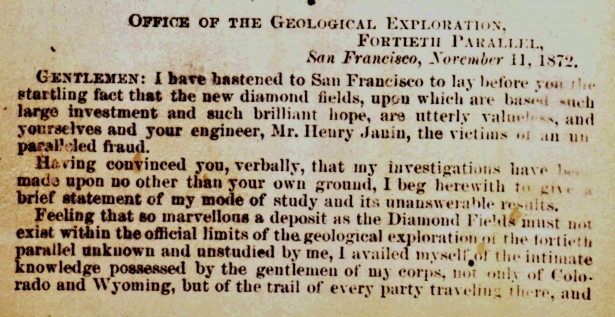

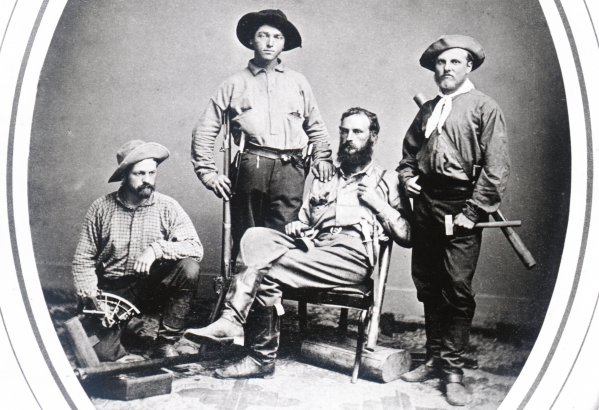

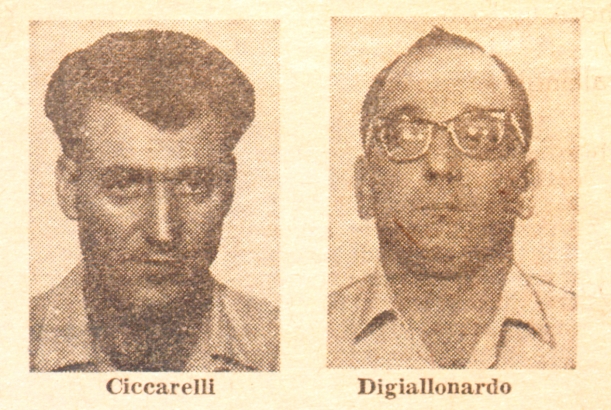
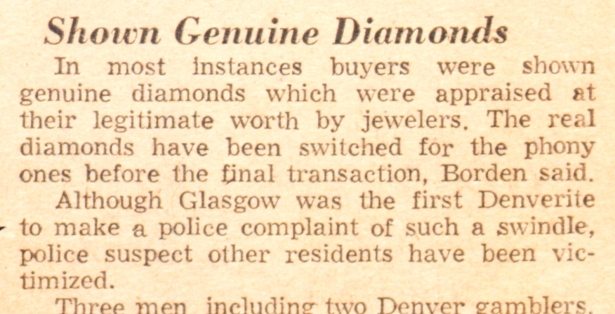
Comments
You may be interested in
You may be interested in learning more about Clarence King, founder of USGS. There is an interesting biography. He married a black woman and pretended to be a railroad porter--therefore providing an excuse to be away from home. He was prominent in government and had some very influential friends. His secret Life was revealed only by his death.
Add new comment